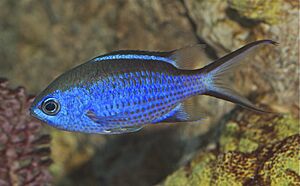Blue chromis facts for kids
Quick facts for kids Blue chromis |
|
|---|---|
 |
|
| Conservation status | |
| Scientific classification |
The blue chromis (scientific name: Chromis cyanea) is a type of damselfish. These colorful fish live in the warm waters around Bermuda, southern Florida, and the Caribbean Sea. They are known for their bright blue color and graceful swimming.
Contents
Where Do Blue Chromis Live?
Blue chromis fish love shallow waters. You can often find them about 3 to 5 meters (10 to 16 feet) deep. But sometimes, they swim much deeper, down to 25 meters (82 feet) below the sea level. Some have even been seen as deep as 60 meters (197 feet)!
These fish usually live near coral reefs. They like to stay close to the reef's surface. But they also swim above the reefs in the open water. This is where they find their food.
What Do Blue Chromis Eat?
Blue chromis mainly eat tiny living things called plankton. Plankton are very small plants and animals that float in the ocean. The blue chromis swims in the water above the reefs to catch these tiny meals.
How Do Blue Chromis Behave?
Blue chromis are often seen alone or in small groups. They like to stay close to the coral reefs, which gives them a safe place to hide.
Younger blue chromis fish stay even closer to the bottom of the reef. This helps them avoid bigger fish that might try to eat them.
When it's time to have babies, the male blue chromis finds a special spot on the reef. This spot becomes his breeding territory. He mates with several females. After the females lay their eggs, the male guards them carefully. He stays with the eggs until the tiny baby fish, called larvae, hatch and swim away.
Why Are Blue Chromis Important?
Blue chromis are sometimes caught and sold for home aquariums. They are popular because of their beautiful blue color. Damselfish, like the blue chromis, are one of the most common types of fish collected for aquariums around the world.
What Threats Do Blue Chromis Face?
Even though blue chromis are common, they face some challenges:
- Lionfish: A big threat comes from lionfish. These fish are not native to the Caribbean. They have spread quickly and eat many smaller fish, including the blue chromis.
- Coral Reef Health: The health of coral reefs is very important for blue chromis. If coral reefs are damaged or disappear, it could harm these fish. Scientists are still studying how much this affects the blue chromis.
What Is Their Conservation Status?
The good news is that the blue chromis is currently listed as "Least Concern" by the IUCN (International Union for Conservation of Nature). This means they are not in immediate danger of disappearing.
Even though they live in a specific area, there are many of them. Their numbers don't seem to be going down. While some are collected for aquariums, it's not in huge numbers that would threaten the species. However, scientists still want to study them more. They want to understand how changes to the ocean environment in the Caribbean might affect the blue chromis in the future.



